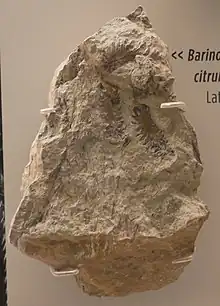| Barinophyton Temporal range: | |
|---|---|
 | |
| Barinophyton citruliforme fossil, New York State Museum | |
| Scientific classification | |
| Kingdom: | Plantae |
| Clade: | Tracheophytes |
| Clade: | †Barinophytes |
| Genus: | †Barinophyton White (1905)[2] emend. Brauer (1980)[3] |
| Species | |
| |
| Synonyms | |
| |
Barinophyton was a genus of early land plant with branching axes. It is placed in a group of early vascular plants (tracheophytes), the barinophytes, a group that has been given various ranks and scientific names.[4] Known fossils are of Devonian to Carboniferous age (419 to 299 million years ago).[1]
Phylogeny
Kenrick and Crane in 1997 placed two species of Barinophyton along with the genus Protobarinophyton in the Barinophytaceae in their Sawdoniales, well nested within the zosterophylls.[5] A summary cladogram produced by Crane et al. in 2004, shows Barinophyton in the core of a paraphyletic stem group of broadly defined zosterophylls, basal to the lycopsids (living and extinct clubmosses and relatives).[6]
| lycophytes |
| |||||||||||||||||||||
The phylogenetic position of the barinophytes remains disputed. Taylor et al. in 2009 considered the barinophytes to be possible lycopsids rather than zosterophylls.[1] Hao and Xue in 2013 suggested that they were not lycopsids, instead falling between this group and the euphyllophytes.[7]
References
- 1 2 3 Taylor, T.N.; Taylor, E.L. & Krings, M. (2009). Paleobotany, The Biology and Evolution of Fossil Plants (2nd ed.). Amsterdam; Boston: Academic Press. pp. 325–326. ISBN 978-0-12-373972-8.
- ↑ White, D. (1905). "Paleontology". In Smith, G.O. & White, D. (eds.). The Geology of the Perry Basin of South-eastern Maine (PDF). Professional Paper 35. Washington, DC: United States Geological Survey. pp. 35–84. Retrieved 2019-10-28.
- ↑ Brauer, D.F. (1980). "Barinophyton citrulliforme (Barinophytales Incertae Sedis, Barinophytaceae) from the Upper Devonian of Pennsylvania". American Journal of Botany. 67 (8): 1186–1206. doi:10.1002/j.1537-2197.1980.tb07752.x. Cited in Brauer (1981).
- ↑ Brauer, David F. (1981). "Heterosporous, barinophytacean plants from the upper Devonian of North America and a discussion of the possible affinities of the Barinophytaceae". Review of Palaeobotany and Palynology. 33 (2–4): 347–362. doi:10.1016/0034-6667(81)90092-0.
- ↑ Kenrick, Paul & Crane, Peter R. (1997). The Origin and Early Diversification of Land Plants: A Cladistic Study. Washington, D.C.: Smithsonian Institution Press. p. 172. ISBN 978-1-56098-730-7.
- ↑ Crane, P.R.; Herendeen, P. & Friis, E.M. (2004). "Fossils and plant phylogeny". American Journal of Botany. 91 (10): 1683–99. doi:10.3732/ajb.91.10.1683. PMID 21652317.
- ↑ Hao, Shougang & Xue, Jinzhuang (2013). The early Devonian Posongchong flora of Yunnan: a contribution to an understanding of the evolution and early diversification of vascular plants. Beijing: Science Press. pp. 55, 246. ISBN 978-7-03-036616-0. Retrieved 2019-10-28.
External links
- Cladogram Archived 2012-12-04 at archive.today from Crane, Herendeen & Friis 2004